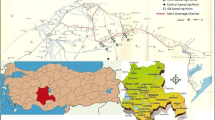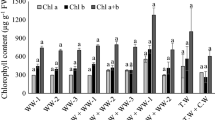Abstract
During this study, the effect of applying several types of treated domestic wastewater on the translocation and accumulation of organic and inorganic micropollutants in soil and radish plants (Raphanus sativus L.) was examined. Primary (PTW), secondary (STW) and tertiary (TTW) treated wastewater as well as tap water (TW) were used for the irrigation of radish plants for a period (transplantating and harvesting) of 67 days. Higher concentrations of polycyclic aromatic hydrocarbons (PAHs) were observed in soils irrigated with PTW. The concentration of PAHs in radish roots ranged between 107.6 ± 12.1 μg/kg for plants irrigated with TTW and 124.1 ± 17.7 μg/kg for plants irrigated with PTW. The root concentration factors (RCFs) expressed as the ratio of PAH concentration in the root mass (dry weight) to the residual concentration in the soil varied from 1.6 to 1.9 indicating a higher accumulation of PAHs in the edible part of radishes than soil. Heavy metals were not detected in the wastewaters utilised and, as a result, no accumulation was found in either the soil or plants in comparison with tap water. RCFs for heavy metals were calculated between 0.91 and 0.99, 0.49 and 0.66, 0.004 and 0.005 for Cu, Zn and Ni, respectively. The results showed that radishes have the ability to concentrate PAHs when they are present in the wastewater and this could have associated health risks.


Similar content being viewed by others
References
Antoniadis, V., & Alloway, B. J. (2001). Availability of Cd, Ni and Zn to rye grass in sewage sludge-treated soils at different temperatures. Water, Air, and Soil Pollution, 132, 201–214.
APHA (American Public Health Association). (1995). Standard methods for the examination of water and wastewater (19th ed.). Washington, DC: American Public Health Association Inc.
Bhogal, A., Nicholson, F. A., Chambers, B. J., & Shepherd, M. A. (2003). Effects of past sewage sludge additions on heavy metal availability in light textured soils: implications for crop yields and metal uptakes. Environmental Pollution, 121, 413–423.
Blanchard, M., Teil, M. J., Carru, A. M., Ollivon, D., Garban, B., Chesterikoff, A., et al. (1999). PCB and PAH impacts on cytochrome P-450-dependent oxidases in roach (Rutilus rutilus) from the Seine river (France). Archives of Environmental Contamination and Toxicology, 37, 242–250.
Cai, Q. Y., Mo, C. H., Wu, Q. T., & Zeng, Q. Y. (2008). Polycyclic aromatic hydrocarbons and phthalic acid esters in the soil–radish (Raphanus sativus) system with sewage sludge and compost application. Bioresource Technology, 99, 1830–1836.
Fatta-Kassinos, D., Kalavrouziotis, I. K., Koukoulakis, P. H., & Vasquez, M. I. (2011). The risks associated with wastewater reuse and xenobiotics in the agroecological environment. Science of the Total Environment, 409, 3555–3563.
Gupta, S., Satpati, S., Nayek, S., & Garai, D. (2010). Effect of wastewater irrigation on vegetables in relation to bioaccumulation of heavy metals and biochemical changes. Environmental Monitoring and Assessment, 165, 169–177.
Huibers, F., & Van Lier, J. (2005). Use of wastewater in agriculture: the water chain approach. Irrigation and Drainage, 54, S3–S9.
January, M. C., Cutright, T. J., Keulen, H. V., & Wei, R. (2008). Hydroponic phytoremediation of Cd, Cr, Ni, As, and Fe: can Helianthus annuus hyperaccumulate multiple heavy metals? Chemosphere, 70, 531–537.
Kachenko, A. G., & Singh, B. (2006). Heavy metal contamination in vegetables grown in urban and metal smelter contaminated sites in Australia. Water, Air, and Soil Pollution, 169, 101–123.
Kalavrouziotis, I. K., Koukoulakis, P. H., Robolas, P., Papadopoulos, A. H., & Pantazis, V. (2008). Interrelationships of heavy metals macro and micronutrients, and properties of a soil cultivated with Brassica oleracea var. italica (Broccoli), under the effect of treated municipal wastewater. Water, Air, and Soil Pollution, 190, 309–321.
Kalavrouziotis, I. K., Koukoulakis, P., & Kostakioti, E. (2012). Assessment of metal transfer factor under irrigation with treated municipal wastewater. Agricultural Water Management, 103, 114–119.
Kapusta, L. A. (2004). Establishing eco-SSLS for PAHs: lessons revealed from a review of literature on exposure and effects to terrestrial receptors. Human and Ecological Risk Assessment, 10, 185–205.
Khan, S., Aijun, L., Zhang, S., Hu, Q., & Zhu, Y. G. (2008). Accumulation of polycyclic aromatic hydrocarbons and heavy metals in lettuce grown in the soils contaminated with long-term wastewater irrigation. Journal of Hazardous Materials, 152, 506–515.
Khan, S., & Cao, Q. (2011). Human health risk due to consumption of vegetables contaminated with carcinogenic polycyclic aromatic hydrocarbons. Journal of Soil and Sediments, 12, 178–184.
Mangas, E., Vaquero, M. T., Comellas, L., & Broto-Puig, F. (1998). Analysis and fate of aliphatic hydrocarbons, linear alkylbenzenes, polychlorinated biphenyls and polycyclic hydrocarbons in sewage sludge-amended soils. Chemosphere, 36, 61–72.
Manoli, E., & Samara, C. (1996). Polycyclic aromatic hydrocarbons in waste waters and sewage sludge: extraction and clean-up for HPLC analysis with fluorescence detection. Chromatographia, 43, 135–142.
Mapanda, F., Mangwayana, E. N., Nyamangara, J., & Gille, K. E. (2005). The effect of long-term irrigation using wastewater on heavy metal contents of soils under vegetables in Harare. Zimbabwe. Agriculture, Ecosystems and Environment, 107, 151–165.
Morillo, E., Romero, A. S., Maqueda, C., Madrid, L., Ajmone-Marsan, H., Grcman, C. M., et al. (2007). Soil pollution by PAHs in urban soils: a comparison of three European cities. Journal of Environmental Monitoring, 9, 1001–1008.
Nadal, M., Schuhmacher, M., & Domingo, J. L. (2004). Levels of PAHs in soil and vegetation samples from Tarragona County. Spain. Environmental Pollution, 132, 1–11.
Papageorgopoulou, A., Manoli, E., Touloumi, E., & Samara, C. (1999). Polycyclic aromatic hydrocarbons in the ambient air of Greek towns in relation to other atmospheric pollutants. Chemosphere, 39, 2183–2199.
Pedrero, F., & Alarcón, J. J. (2009). Effects of treated wastewater irrigation on lemon trees. Desalination, 246, 631–639.
Pollice, A., Lopez, A., Laera, G., Rubino, P., & Lonigro, A. (2004). Tertiary filtered municipal wastewater as alternative water source in agriculture: a field investigation in Southern Italy. Science of the Total Environment, 324, 201–210.
Qadir, M., Wichelns, D., Raschid-Sally, L., McCornick, P. G., Drechsel, P., Bahri, A., et al. (2010). The challenges of wastewater irrigation in developing countries. Agricultural Water Management, 97, 561–568.
Raschid-Sally, L., Carr, R., & Buechler, S. (2005). Managing wastewater agriculture to improve livelihoods and environmental quality in poor countries. Irrigation and Drainage, 54, S11–S22.
Rattan, R. K., Datta, S. P., Chhonkar, P. K., Suribabu, K., & Singh, A. K. (2005). Long-term impact of irrigation with sewage effluents on heavy metal content in soils, crops and groundwater—a case study. Agriculture, Ecosystems and Environment, 109, 310–322.
Rosenqvist, H., Aronsson, O., Hasselgren, K., & Perttu, K. (1997). Economics of using municipal wastewater irrigation of willow coppice crops. Biomass and Bioenergy, 12, 1–8.
Song, Y. F., Wilke, B. M., Song, X. Y., Gong, P., Zhou, Q. X., & Yang, G. F. (2006). Polycyclic aromatic hydrocarbons (PAHs), polychlorinated biphenyls (PCBs) and heavy metals (HMs) as well as their genotoxicity in soil after long-term wastewater irrigation. Chemosphere, 65, 1859–1868.
Sorme, L., & Legerkvist, R. (2002). Sources of heavy metals in urban wastewater in Stockholm. Science of the Total Environment, 235, 143–150.
US EPA method 3541. (1994). US Government Printing Office, Washington, USA. available at: http://www.epa.gov/epawaste/hazard/testmethods/sw846/pdfs/3541. pdf (available at 22/3/2013).
Voutsa, D., & Samara, C. (1998). Dietary intake of trace elements and polycyclic aromatic hydrocarbons via vegetables grown in an industrial Greek area. Science of the Total Environment, 218, 203–216.
Wang, Y.-C., Qiao, M., Liu, Y.-X., Arp, H. P. H., & Zhu, Y.-G. (2011). Comparison of polycyclic aromatic hydrocarbon uptake pathways and risk assessment of vegetables from waste-water irrigated areas in northern China. Journal of Environmental Monitoring, 13, 433–439.
Wild, E., Dent, J., Barber, J. L., Thomas, G. O., & Jones, K. C. (2004). A novel analytical approach for visualing and tracking organic chemicals in plants. Environmental Science and Technology, 38, 4195–4199.
Zabalaga, J., Amy, G., & von Münch, E. (2007). Evaluation of agricultural reuse practices and relevant guidelines for the Alba Rancho WWTP (primary and secondary facultative ponds) in Cochabamba, Bolivia. Water Science and Technology, 55(1–2), 469–475.
Zohair, A., Salim, A. B., Soyibo, A. A., & Beck, A. J. (2006). Residues of polycyclic aromatic hydrocarbons (PAHs), polychlorinated biphenyls (PSBs) and organochlorine pesticides in organically-farmed vegetables. Chemosphere, 63, 541–553.
Acknowledgments
This research was co-funded by the LIFE project ENV/GR/00551.
Author information
Authors and Affiliations
Corresponding author
Rights and permissions
About this article
Cite this article
Petousi, I., Fountoulakis, M.S., Tzortzakis, N. et al. Occurrence of Micro-pollutants in a Soil–Radish System Irrigated with Several Types of Treated Domestic Wastewater. Water Air Soil Pollut 225, 1791 (2014). https://doi.org/10.1007/s11270-013-1791-y
Received:
Accepted:
Published:
DOI: https://doi.org/10.1007/s11270-013-1791-y




